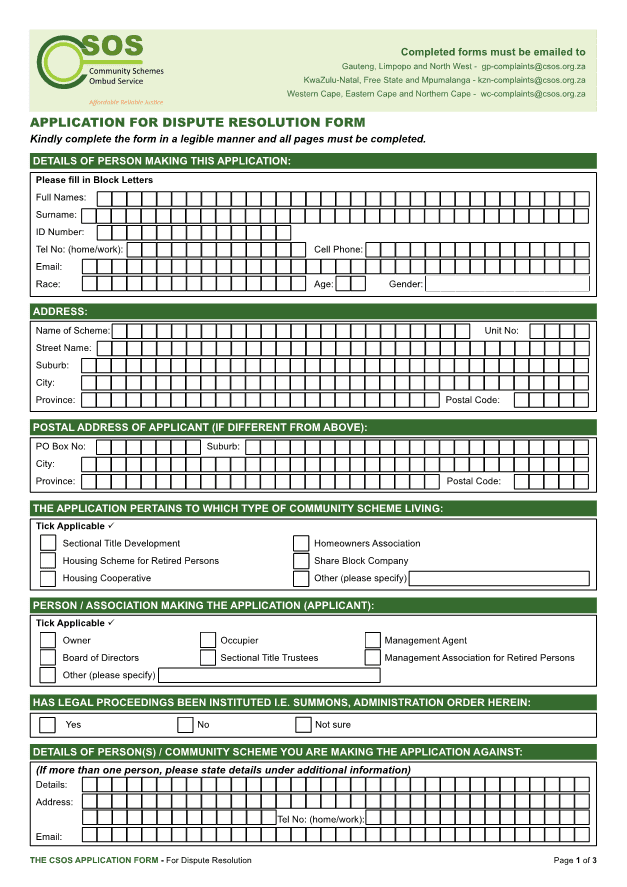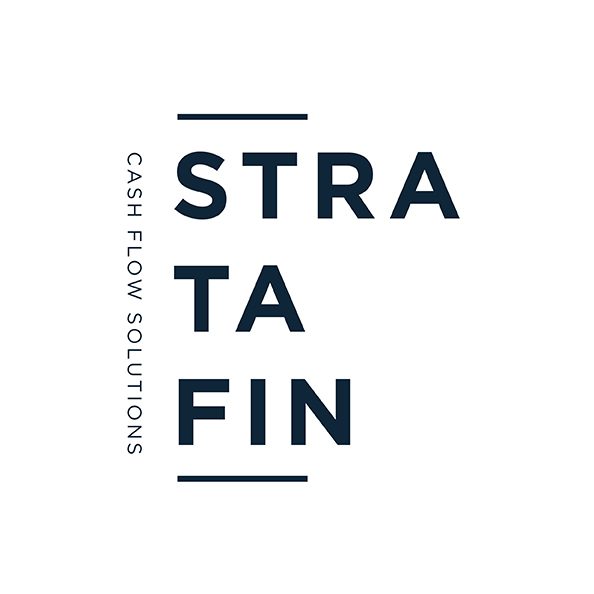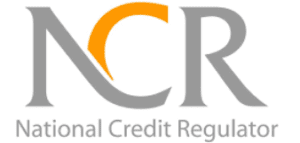Introduction
The Community Schemes Ombud Service (the “CSOS”) is a quick and cheap alternative dispute resolution body designed to resolve administrative disputes in all types of community schemes, including sectional title schemes. The CSOS is designed to provide an alternative, impartial and transparent service for the resolution of administrative disputes in community schemes.
In my last article I discussed who can make applications to the CSOS; what kind of disputes the CSOS can deal with; submitting applications for dispute resolution; the right to legal representation; how the CSOS deals with disputes; and the right of appeal. In this article I will give the actual Application for Dispute Resolution Form and break down how the Trustees of a Body Corporate should fill it in to initiated dispute resolution proceeding at the CSOS.
Application for Dispute Resolution Form
See below:



- Breakdown of Application form
The first page of the Application for Dispute Resolution Form deals with the details of the person making the Application, and the address of the Scheme and Applicant. We suggest that one of the Trustees or the Managing Agent make the Application on behalf of the Body Corporate.
Further details required are:
- The type of community scheme – check the “Sectional Title Development” box.
- The person making the Application – check the “Sectional Title Trustee” or “Managing Agent” box.
- Whether legal proceeding has been instituted – check the “No” box.
- Person/Association the Application is against – We suggest you attach a register of the affected owners as well the appropriate details of the owners
The second page of the Application for Dispute Resolution Form deals with the facts of the Application and the alleged breach. We recommend that the following wording be used:
“Please refer to the Cover Letter for the facts of the Application and the alleged breach.” (and then add a Cover Letter)
The second page of the Application for Dispute Resolution Form also deals with the exhaustion of internal remedies – The Cover Letter should list the manners in which the Body Corporate have attempted to resolve the matter. Here you will state, for example, that the Body Corporate took legal advice on the dispute. We suggest that the Body Corporate include some or all of the following documents (depending on whether they are relevant to the circumstances and facts of the dispute):
- Any legal opinion or advice received.
- All documents to show that the Trustees’ failed attempts to resolve the matter internally, including the notice and minutes (including resolutions taken) of the meetings at which the dispute was discussed or attempted to be resolved.
- Any correspondence that relates to the matter.
- Sectional Plans.
- Photographs or videos.
- Any other documentation and/or correspondence relating to the matter.
- The Scheme’s Management and Conduct Rules
- Finally, mention that internal resolution could not be achieved.
Finally, the second page requires a summary of the relief sought. We recommend that the following wording be used:
“The Trustees request that the CSOS use the discretion granted to them in terms of (insert provision of applicable order)”
Here is an example:
“The Trustees request that the CSOS use the discretion granted to them in terms of section 6(9) of the STSM Act whereby a Body Corporate who is unable to obtain a special or unanimous resolution may approach the chief ombud for relief.”
The final page of the Application for Dispute Resolution Form deals with any additional information as well as Supporting Documentation – We suggest that you list and attach the above-mentioned documents.
It concludes with the declaration and signature of the Applicant. This can be done by the relevant Trustee or Managing Agent.
Final advice
We suggest that the Trustees also take and have a Trustee Resolution signed by two Trustees authorising the action to submit the Application for Dispute Resolution.
WRITTEN BY DR CARRYN DURHAM







![Case discussion on SS Glen High v Kruger NO ((2023/055133) [2024] ZAGPJHC 1059 (10 September 2024)](https://b2659803.smushcdn.com/2659803/wp-content/uploads/2024/10/OIP-300x200.jpeg?lossy=1&strip=1&webp=1)




